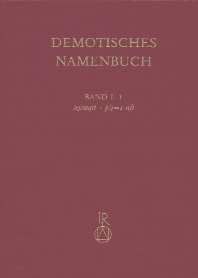| Main » Ad Board » ДРЕВЕН ЕГИПЕТ И АФРИКА » Език и писменост |
| 04.10.2019, 07:01 | |
Речникът на демотическите имена на немския египтолог Ерих Людекенс (1913-2004) е незаменимо пособие при изучаването на езика и цивилизацията на Египет през Късния период. Имената са представени в прецизно изписване с демотическо писмо, придружени са с подробни коментари и обширен справочен апарат. Книгата може да бъде от помощ както за египтолози, така и за религиоведи и за изучаващи различни други култури в Древния Близък Изток и Източното Средиземноморие. През тази епоха Египет влиза особено интензивно в международните отношения и броят на имената с чуждестранен произход е изключително голям. Erich Lüddeckens - Demotisches Namenbuch. Band I, Wiesbaden, Dr. Ludwig Reichert Verlag, 2000 Erich Lüddeckens - Demotisches Namenbuch. Band I, Wiesbaden, Dr. Ludwig Reichert Verlag, 2000 (алтернативен линк/alternative link) АЛТЕРНАТИВНИ ЛИНКОВЕ / ALTERNATIVE LINKS: Erich Lüddeckens - Demotisches Namenbuch. Band I, Wiesbaden, Dr. Ludwig Reichert Verlag, 1980: - на древноегипетски език (демотическо писмо) и немски език, от Google Drive,формат PDF. Сваляне с ляв бутон (downloading by left button) от страницата на предоставящия сървър, после през бутона стрелка надолу/after by down arrow button.
| |
| Views: 1190 | Placed till: 04.11.2021 | Rating: 0.0/0 | |

